
The Bottom Line
Introduction, Specifications, and Pricing
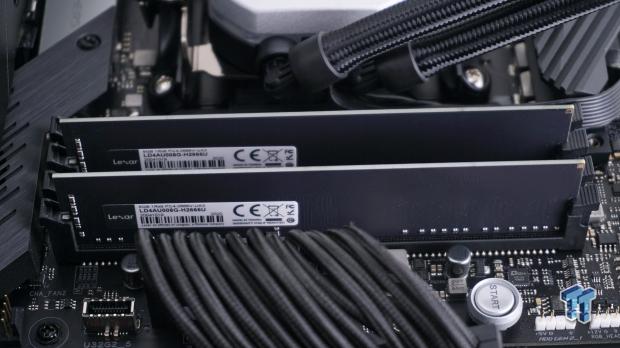
As we hop in the way-back machine and recall some of the first few sets of DDR we owned, we remember using something called "Value Ram" at that time. While it was more affordable than others on the market at that time, many things set it apart. First of all, beyond the cost of the kits, they tended to use mainstream ICs and came with loose timings, which makes them built more for stability than for what mainstream gamers and PC users want in RAM today. If you're going to call it that, the second feature is that these sticks typically came naked, some with green PCBs, but if you were fortunate, they came in black. The whole point of these was a mix of marketing with the "Value Ram" moniker but was also made to run on any system that supported that type of DDR.
As time has passed over the last decade or two, RAM has changed from naked kits to much of the market sporting heat spreaders of various designs. However, as much as we like the look of them, heat spreaders tend to keep the ICs warmer, rather than how marketing spins it as a heat sink of sorts. Then, of course, there was the entry of RGB that is on most of what is available now, and the basic kits seem harder and harder to find as time goes on.
In our minds, as an overclocker at heart, we would much prefer kits with exposed ICs, as we can actively cool the ICs and PCBs better when pushing said kits. Still, we feel the days of old, where you could get excellent ICs on bare looking sticks, may be gone, where our memory leads us to the Samsung low-profile kits that hit the market a few years ago when it was all the rage to buy these kits and clock them to the stars.
While other markers may be part of this lesser purchased market, today, in steps Lexar with what they call "Desktop Memory." Unassuming in its looks, Lexar opts for the stability of their DDR4 in this series over any of that fancy tech that may or may not help the RAM. However, this is one of those instances where we are going in with an open mind and hoping for the best. Lexar sent us nothing special on visual inspection and may make many cringe thinking about the lack of speed and extremely loose timings. Do not judge this book by its cover, as what we are about to show you may turn what you thought about this Lexar Desktop Memory and turn it completely upside down.
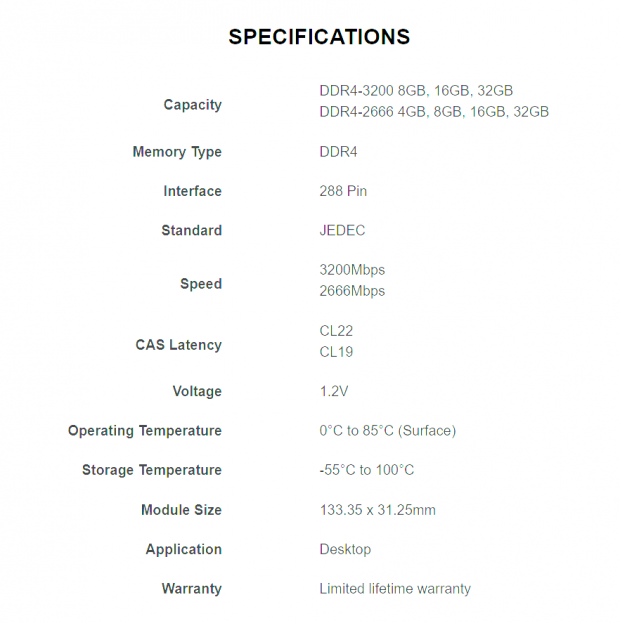
Looking at Lexar's specifications on their product page, we can see that Lexar makes the Desktop Memory in two speeds, 3200 MHz and 2666 MHz. Sticks are sold individually, meaning that you can buy single 8GB, 16GB, or 32GB sticks, which you would need to purchase multiples for dual-channel or quad-channel usage. Of course, this is 288-pin DDR4 UDIMM, and with the kit we have, there is no XMP or DOCP profile, as it works with a JDEC/SPD profile instead. If you are looking to grab the 3200 MHz sticks, you will notice the CAS22 timings, which are super loose for the speed of the sticks, and the same can be said for the CAS19 of the 2666 MHz sticks.
All of these Lexar sticks work with just 1.20VDIMM and are shown to run at temperatures as high as 85°C. The size of the sticks is also displayed, where the overall height is only 31.25mm tall, and are sticks that will fit in any situation, under any cooler. The last bit of information displayed in the chart is that if you were to run into an issue with the Lexar Desktop Memory, it is covered with a limited lifetime warranty.
What we have in hand is the slower of the two, and by model number, we have two packages of LD4AU008-R2666U. What this means is that we have two 8GB sticks of the 2666 MHz stuff. When powered up, we found no XMP or DOCP profile is showing in the UEFI, but the timings of 19-19-19-43 auto-populate the timings section and are the default speed and timings of what we have. In either system, the VDIMM does show up as 1.20V, and even the VCCSA/VCCIO on the Intel rig is low, as is the SOC on the AMD system. While we do not expect much from memory such as this, beyond ease of use and stability, but keep your eyes peeled in the rest of this review, as we do have a couple of surprises along the way.
While the information on the internet is limited to a few news posts and only one listing at an e-tailer, we feel that Lexar jumped into the game with their best foot forward. While we can find the listing for what we have on Amazon, sadly, it shows as currently unavailable, but with the press release, pricing was covered. For the 8GB stick of 2666 MHz CAS19 DDR4, $64.99 is expected to acquire them, and double that for dual-channel users.
All told, for the sticks we have in hand, it will set you back nearly $130, which on appearances is a bit expensive in our opinion. However, there is a good possibility that these Samsung-based sticks could have a trick or two up their sleeves and turn out to be a lot of fun and possibly well worth the current pricing.
Packaging and Lexar Desktop Memory
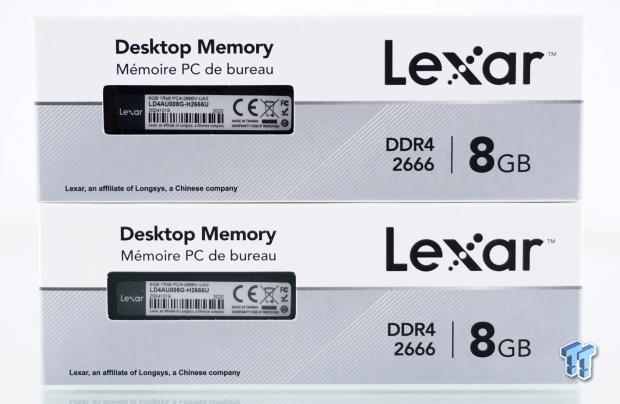
As seen by what we have in this image, we were sent two separate packages, each with an 8GB stick of DDR4 inside the white and gray packages. Simply called Desktop Memory by Lexar, these 2666 MHz stick packages also have a window that allows a view of the product sticker to verify what is inside is what the box said it was.
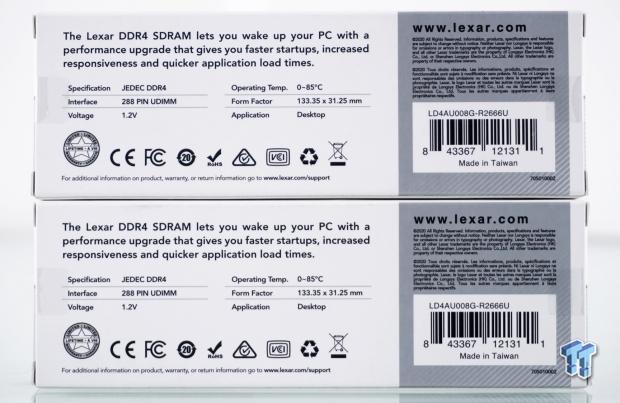
The back of the packaging starts with some of the specifications, which we have already covered. Below are notifications of compliances, along with an icon about the limited lifetime warranty. To the right is the legal information for Lexar, with a box containing the part number again.
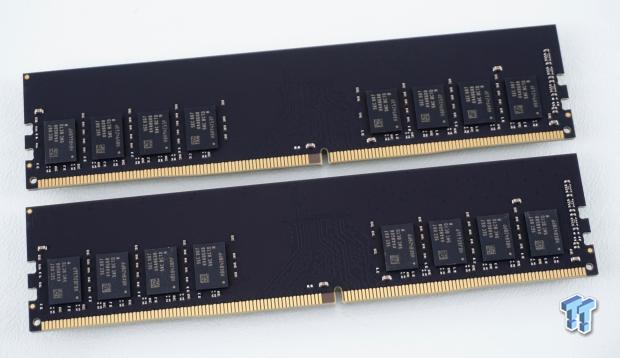
After removing the RAM from the packaging, we can see no marketing hype or features to go along with these sticks. No heat spreaders, no lighting, nothing fancy. What we get is a black PCB with the traces showing, and each houses eight Samsung ICs.
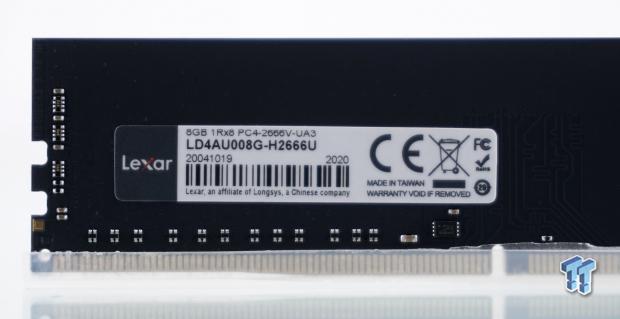
The back of the PCBs contain no ICs, but the traces are visible here too. We find the product sticker at the left end of each stick, which offers the density, speed, part number, and serial number.
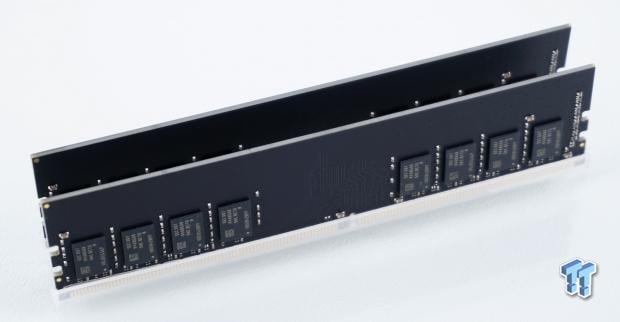
Stood on end, as if they were in a PC, we see again that there is nothing fancy going on. When installed, you will see the edges of the PCBs at the top, but due to the way these are built, you will not see the ICs, just the sticker on the back.
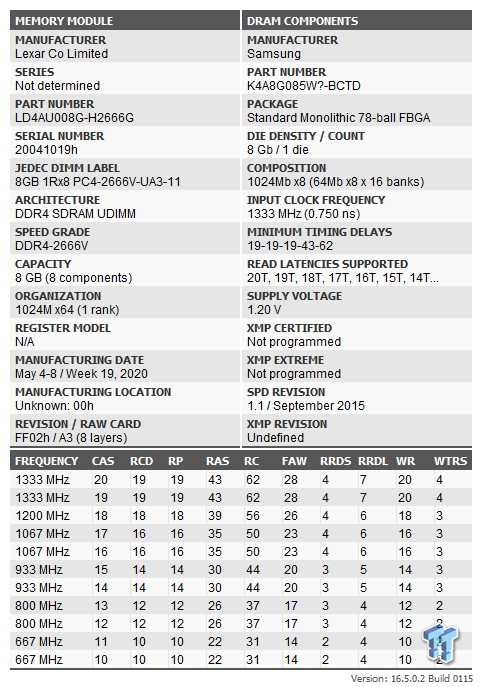
As we do for all RAM, we opened up Thaiphoon Burner and read the SPD profile. Doing so shows us that these are Samsung ICs that are K4A8G05W?-BCTD, that are binned at 2666 MHz, and have incredibly loose timings.
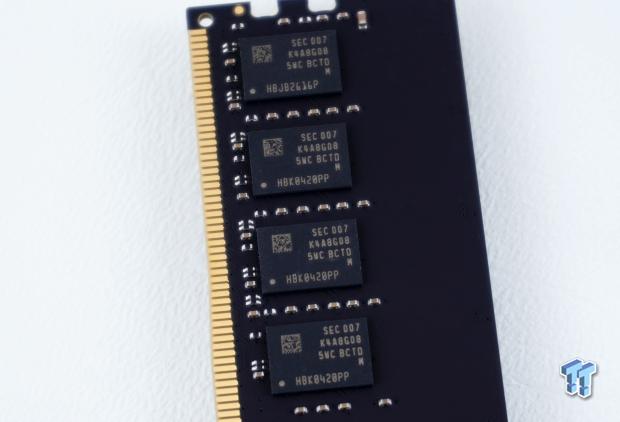
Rather than guess or remove heat spreaders to find out what the "?" is for in Thaiphoon Burner, with naked sticks, we can look at the ICs. Thankfully they were not relabeled so that we can see the whole part number for the ICs is SEC K4A8G085WC-BCTD.
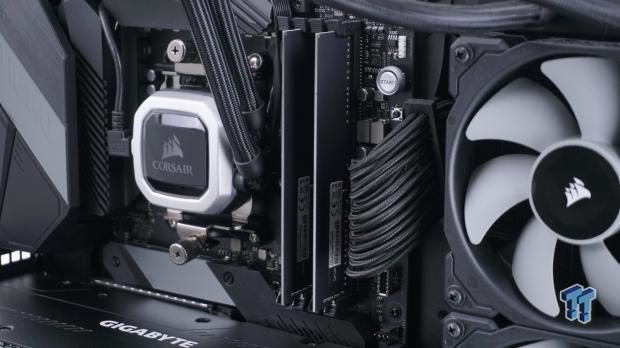
Installed to run with the 3900X we use for RAM testing; we see two naked sticks with quite a bit of space between them. We would rather have had a view of the ICs with these plain sticks, but at least it is easy to see the model number of the sticks if, for some reason, you need that information at a later date.
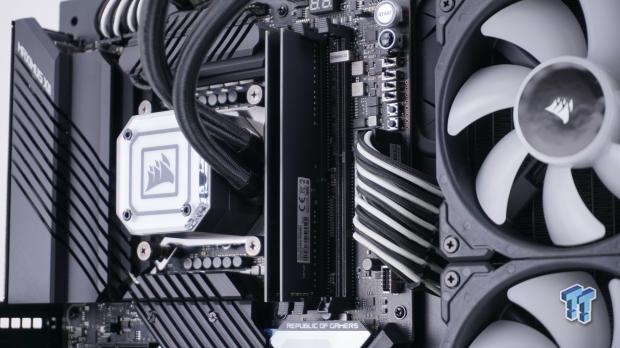
Paired with the 10700K on the Maximus XII, the sticks sit in the slots much closer together. In our minds, these are perfect for a sleeper-style build or for anyone who is against all of the trends that help sell most other DDR4 on the market.
Test System Details
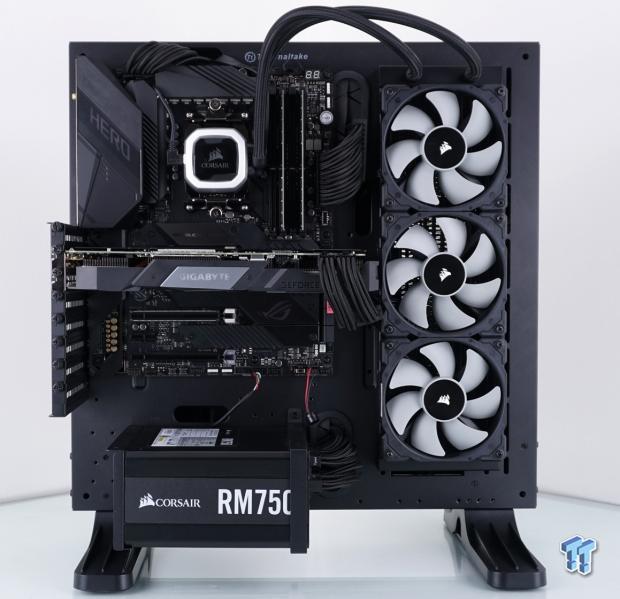
To obtain the AMD CPU-Z screenshots, you will see directly following this image, and this is the system we used to do it, as well as in attaining the results seen in the following pages. Thanks go out to Corsair, ASUS, and GIGABYTE for supporting this venture. Detailed specifications of the system can be found below.
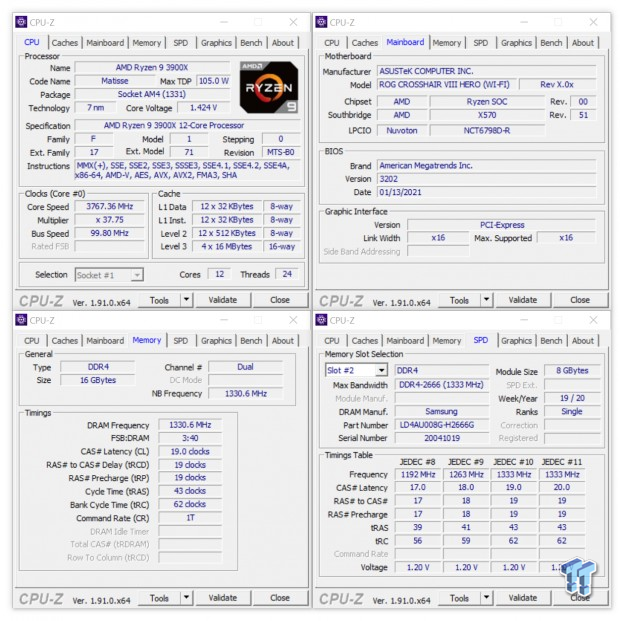
While we do see that the Lexar kit boots at 2666 MHz with 19-19-19-43 timings, we did not enable anything to make this happen. All we did was clear CMOS, power the system on, and the SPD profile kicks in, giving what we are supposed to have with no effort from us at all. We then went back to the UEFI to see voltages and found the VDIMM at 1.20V and our SOC set at 1.016V.
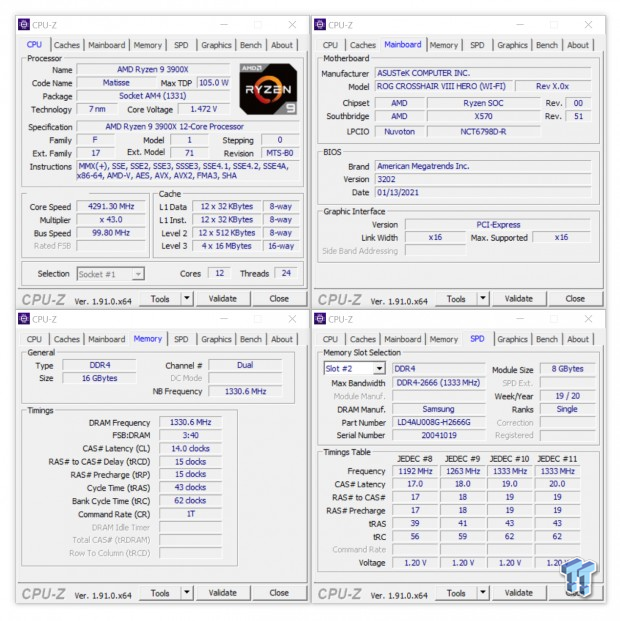
Leaving the speed at 2666 MHz and pushing the timings down worked out well for us. Using 1.35 VDIMM and adjusting the SOC to 1.20V, we were able to get pretty far. While not able to get straight timings stable with these voltages, we could go from 19-19-19 to 14-15-15, which to us is a great thing.
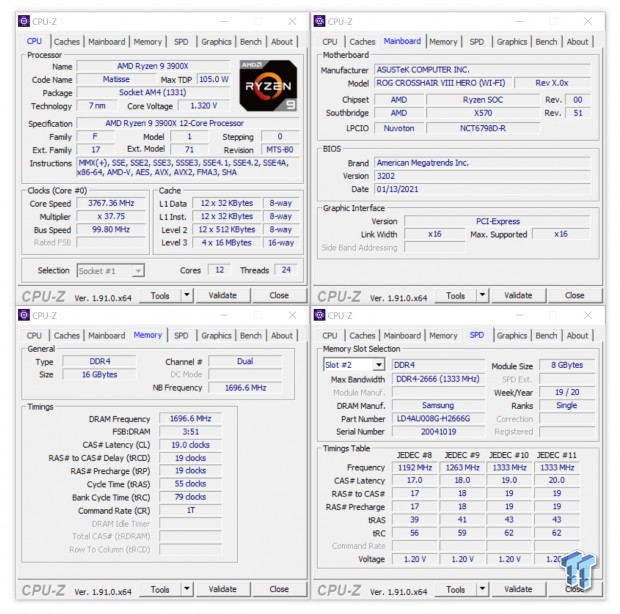
Utilizing the same VDIMM and SOC as the previous run, it was time to push the speed using 19-19-19 timings. Shockingly, these Lexar sticks had a lot to give. Over 700 MHz increase to 3400 MHz is impressive any way you slice it and reminds us of the old Samsung low-profile stuff of days gone by.
Chad's AMD DDR4 Dual-Channel Test System Specifications
- Motherboard: ASUS Crosshair VIII HERO Wi-Fi - Buy from Amazon
- CPU: AMD Ryzen 9 3900X - Buy from Amazon
- Cooler: Corsair H150i PRO - Buy from Amazon
- Video Card: GIGABYTE GeForce RTX 2060 SUPER Gaming OC 8GB - Buy from Amazon
- Storage: Corsair Force MP500 480GB NVMe - Buy from Amazon
- Case: Thermaltake Core P5 TG - Buy from Amazon
- Power Supply: Corsair RM750x 750-watt - Buy from Amazon
- OS: Microsoft Windows 10 Home 64-bit - Buy from Amazon
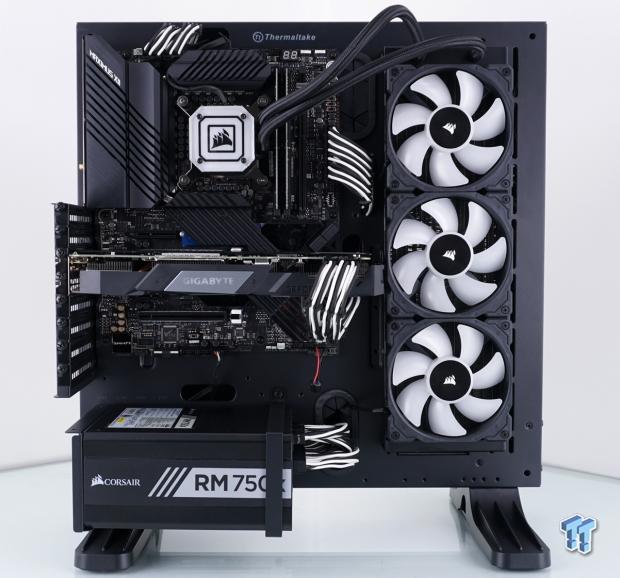
To obtain the Intel CPU-Z screenshots, you will see directly following this image, and this is the system we used to do it, as well as in attaining the results seen in the following pages. Thanks go out to Corsair, ASUS, and GIGABYTE for supporting us here too! Detailed specifications of the system can be found below.
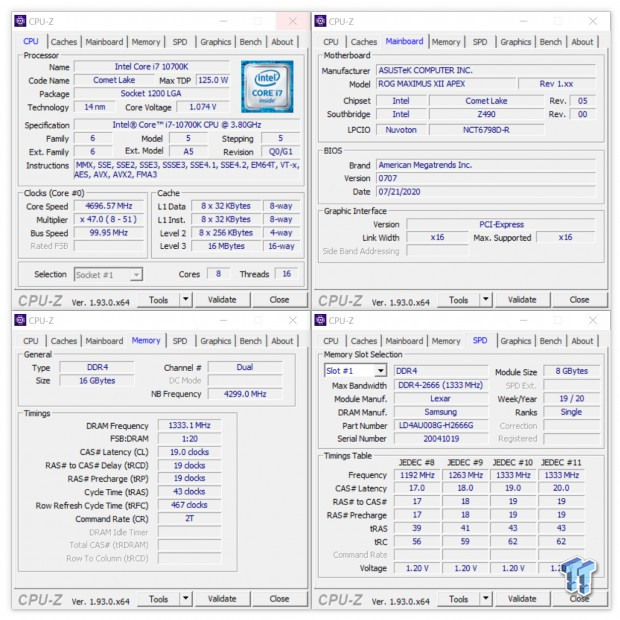
The same procedure is used for clearing CMOS, booting, and seeing what shakes applied to the Intel system. The SPD settings give us 2666 MHz with 19-19-19-43 timings, using 1.20 VDIMM, 1.152 VCCSA, and 1.136 VCCIO.
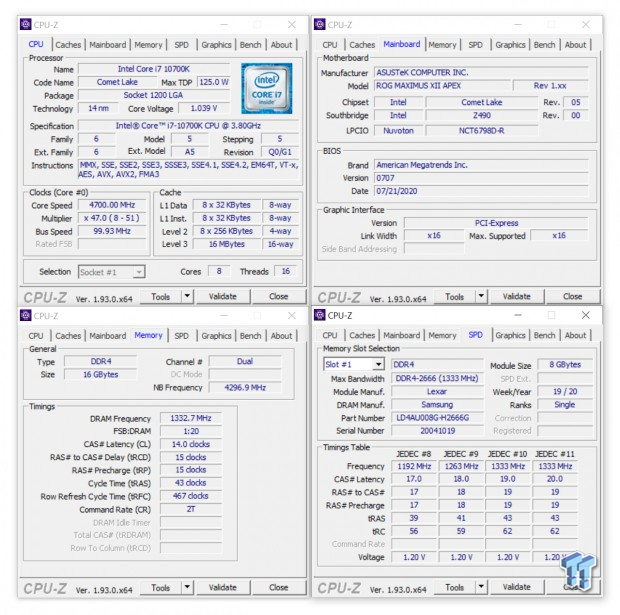
Looking for the lowest possible, stable timings, we did increase the VDIMM to 1.35V, and both the VCCSA and VCCIO were set to 1.30V. Doing so allowed us to get the exact lowered timings we saw on the AMD system, 14-15-15-43. Trying 14-14-14 resulted in a no POST situation on both rigs.
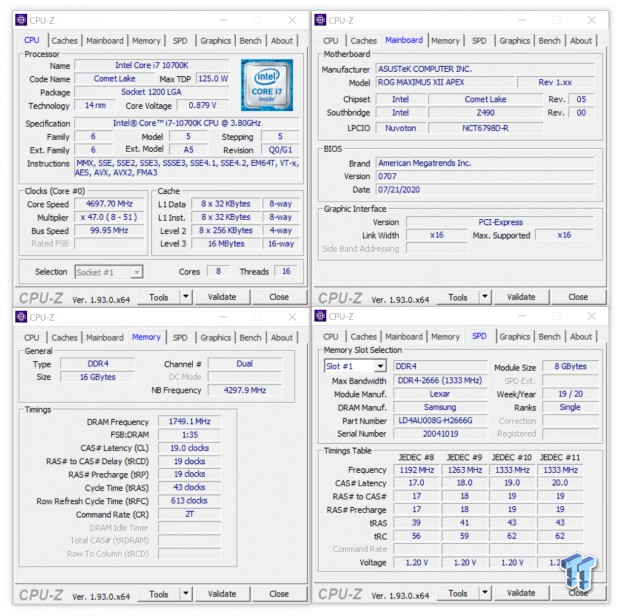
Moving from 1T on the AMD rig to 2T with the Intel system, we could get a tad more out of these Lexar sticks. Using the same voltages as when we lowered the timings, paired with our 10700K, we increased the speed to 3500 MHz, some 834 MHz of free speed.
Chad's Intel DDR4 Dual-Channel Test System Specifications
- Motherboard: ASUS ROG Maximus XII Apex - Buy from Amazon
- CPU: Intel Core i7 10700K - Buy from Amazon
- Cooler: Corsair iCUE H150i Elite Capellix - Buy from Amazon
- Video Card: GIGABYTE GeForce RTX 2060 SUPER Gaming OC 8GB - Buy from Amazon
- Storage: Intel SSDPEK1W120GA
- Case: Thermaltake Core P3 - Buy from Amazon
- Power Supply: Corsair RM750 - Buy from Amazon
- OS: Microsoft Windows 10 Home 64-bit - Buy from Amazon
AMD Performance
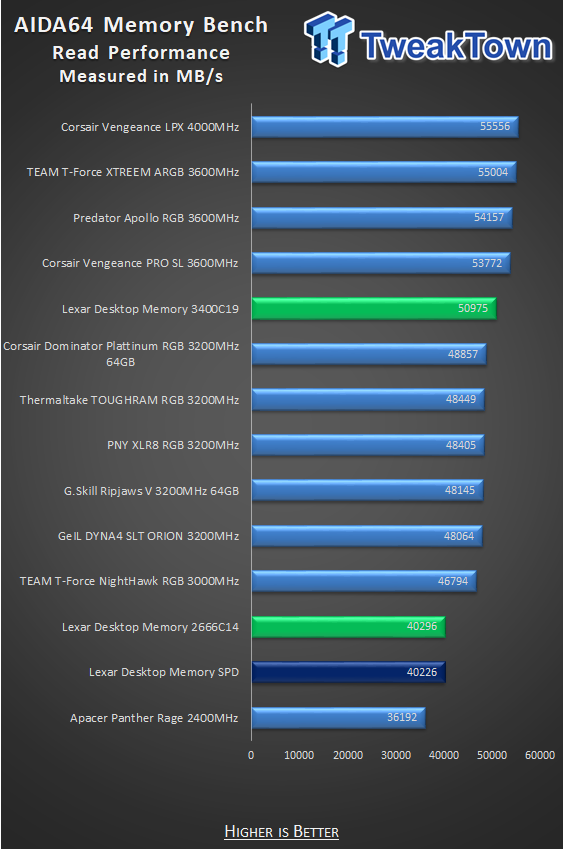
When looking at this read performance chart, it may seem not good for the Lexar kit, but the reality is that it placed right where it should have at 40226 MB/s. Opting for lower timings helped, but only a little, whereas, at 3400 MHz, the Lexar climbed the chart and punched above their speed class. With just the slightest of tinkering and testing, you too can gain 10667 MB/s over the default performance.

Again, in write performance, the SPD run falls right where it should fit into our chart. Opting for lowered timings delivered a small bump in performance, but with all of that free speed on tap, at 3400 MHz, the Lexar jumps into third place with a 9716 MB/s gap over the SPD run.
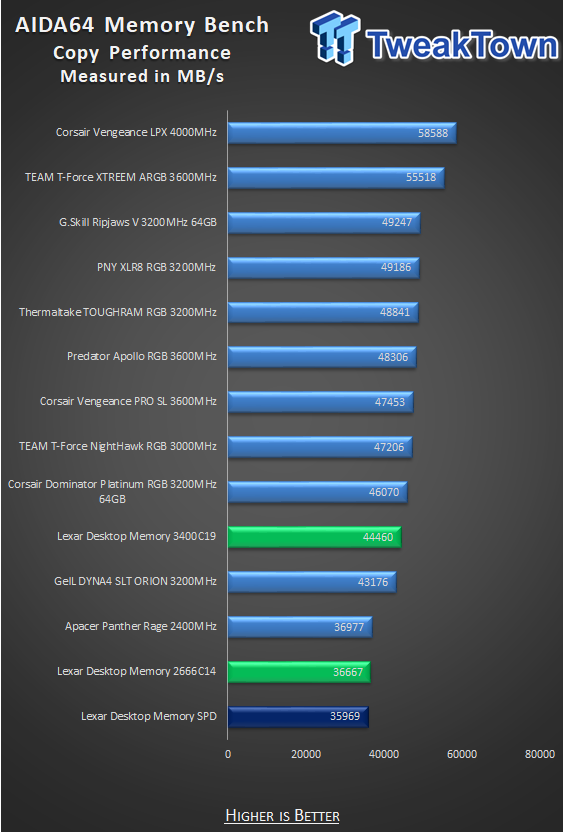
Copy performance out of the box is not all that great. Falling below the Apacer 2400 MHz kit, the results are poor, with no way to spin it positively. However, if you like to tinker, reducing the timings almost ties with the Apacer set, and even though we gained nearly 7800 MB/s opting for mope speed, those results are also lower than expected.
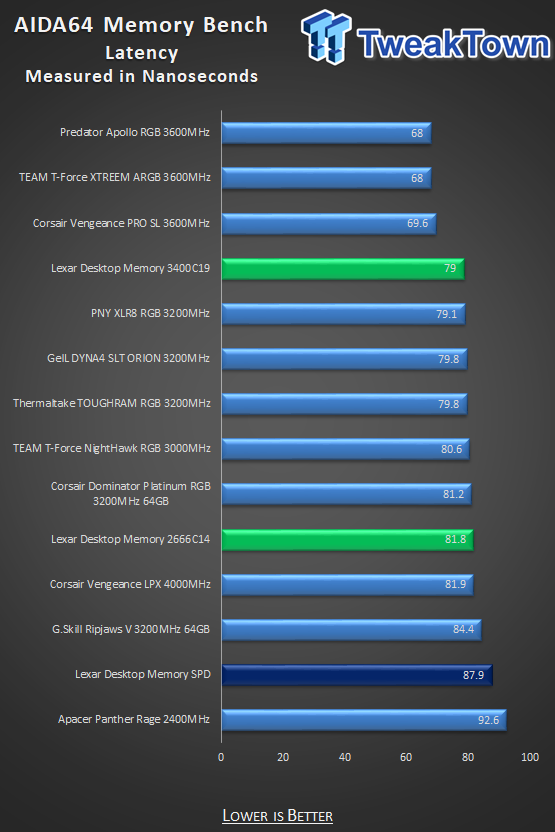
If you are looking for the best latency out of your kit, Lexar may not be your first choice. However, even with the default latency being 87.9ns, the performance is strong. We can reduce latency with both ways of overclocking this kit, but we are still quite a bit from the top of the chart.
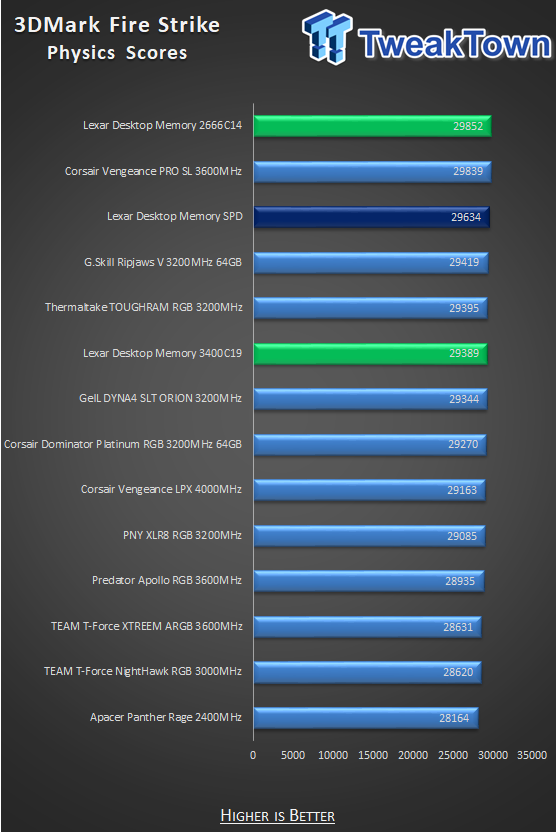
The result you see in this chart is not a mistake, as we ran this suite three times to ensure what we saw was correct. At 2666 MHz with 19-19-198 timings, the Lexar RAM falls into second place; impressive, to say the least. Reducing the timings jumps the Lexar memory into first place, and oddly, adding speed lost us two positions.
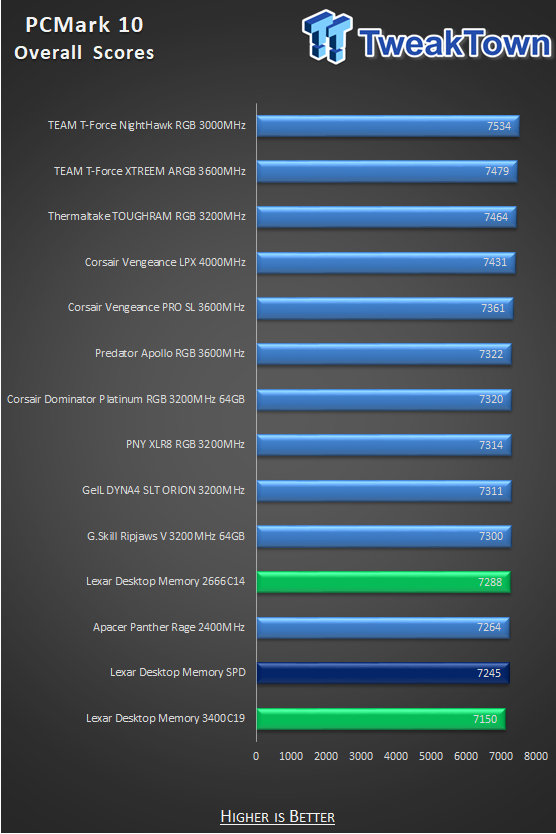
PCMark 10 put the hurt on Lexar with the last-place finish, which is disappointing. In this test, speed kills, as it scores worse than the default settings, and the reduction of timings only yields a few points but can finally surpass the Apacer 2400 MHz kit.
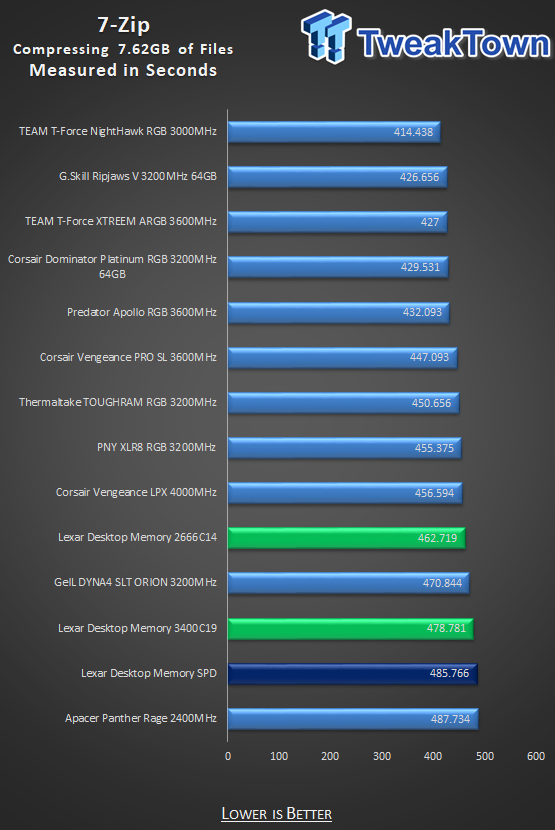
Our compression results with 7-Zip, again, land Lexar where we thought it should land, second from the bottom. Time gained opting for extra speed is minimal, but lowering the timings gains us 23 seconds back for every 7.62GB we compress.
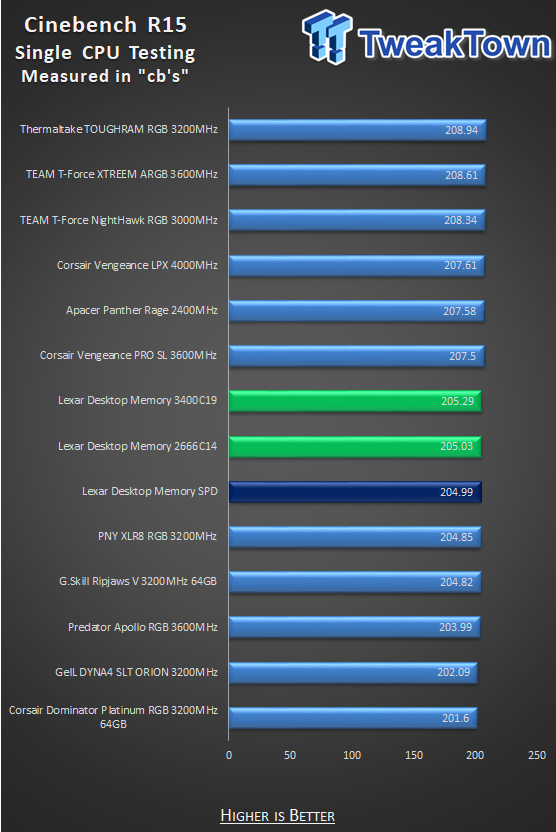
When it comes to Cinebench R15 results, the Lexar DDR4 performs better than expected. Above the bottom of the chart is a nice place to be, right in the middle, at just 2666C19. Overclocking yielded some improvement but did not change the position that it falls into.
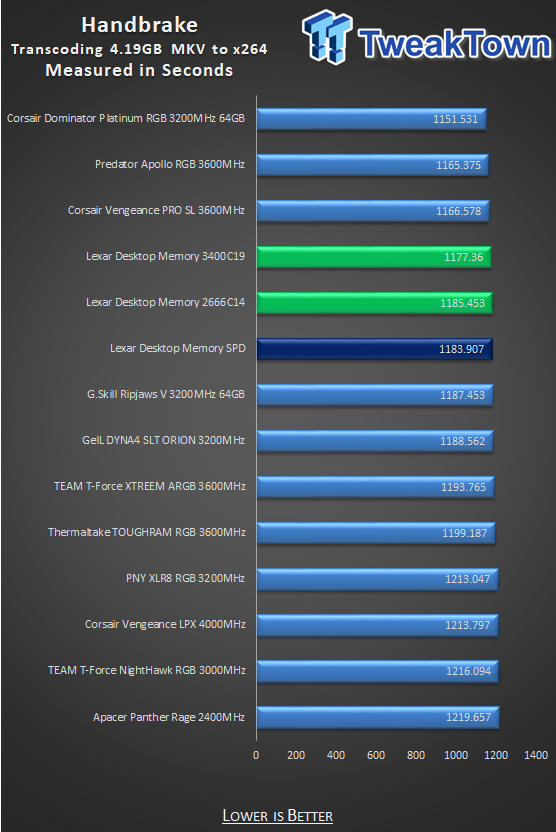
Using Handbrake for transcoding also impresses us with the results we see. In fourth place overall, Lexar can surpass many faster sets of DDR4 along the way. From the best time to the worst time it takes in this test, there is only a six-second spread between all three results.
Intel Performance
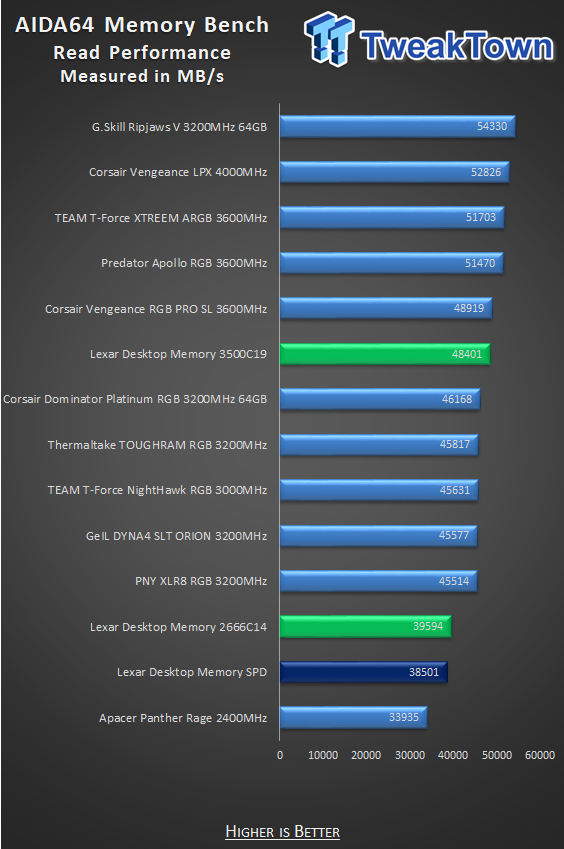
Back to testing in AIDA64, we see that when it comes to read performance, that the Lexar sticks are better than the slower Apacer, which is what should happen. We gained over 1000 MB/s opting for reduced timings, but opting to run these at 3500 MHz delivered us a 9900 MB/s advantage over the SPD results.
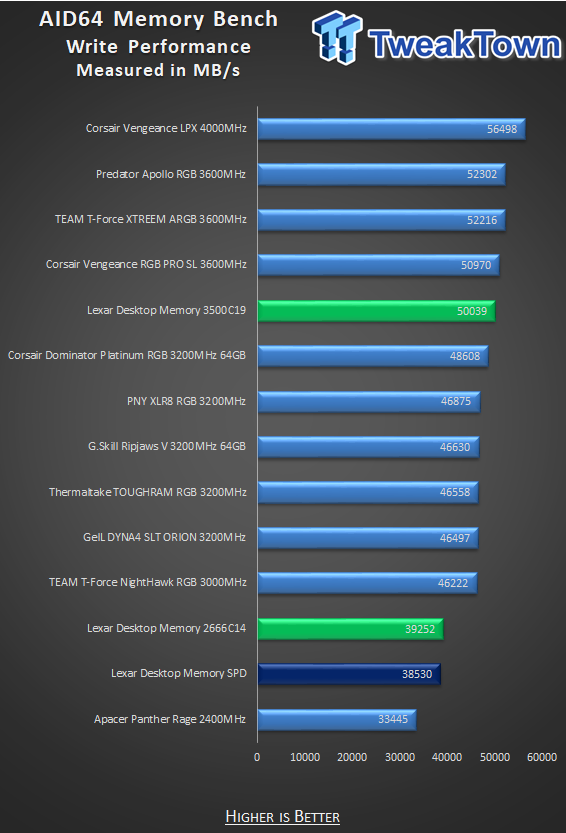
Again, the write performance of the Lexar Desktop Memory is roughly what we expected to see, slightly better than our slowest kit tested. Tightening the timings offers a 722 MB/s boost in performance, while more speed gave us 11509 MB/s more to utilize.
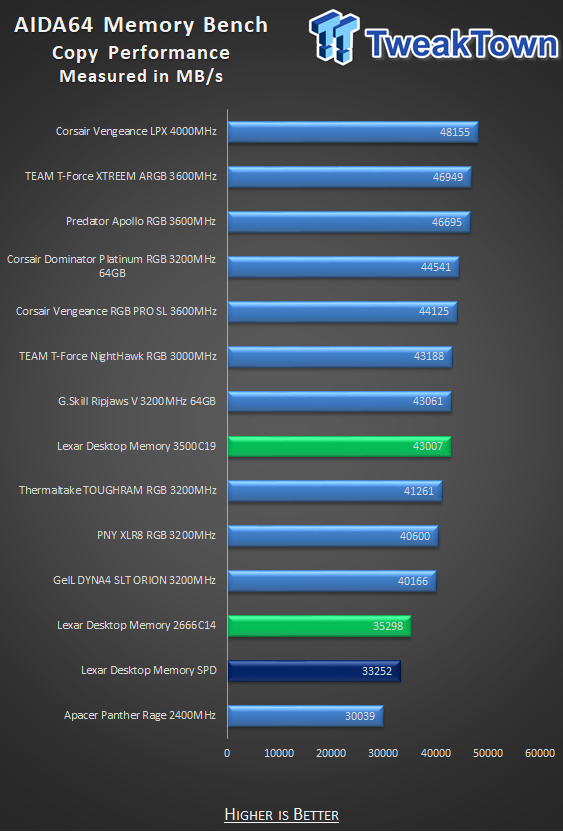
Unlike the bottom of the barrel performance we saw on the AMD system, in the Intel rig, we see that Lexar again falls where it should into our chart for copy performance, which is better than the slowest kit. We also see an increase of slightly more than 2000 MB/s opting to lower the timings and almost 10000 MB/s running the Lexar at 3500 MHz.
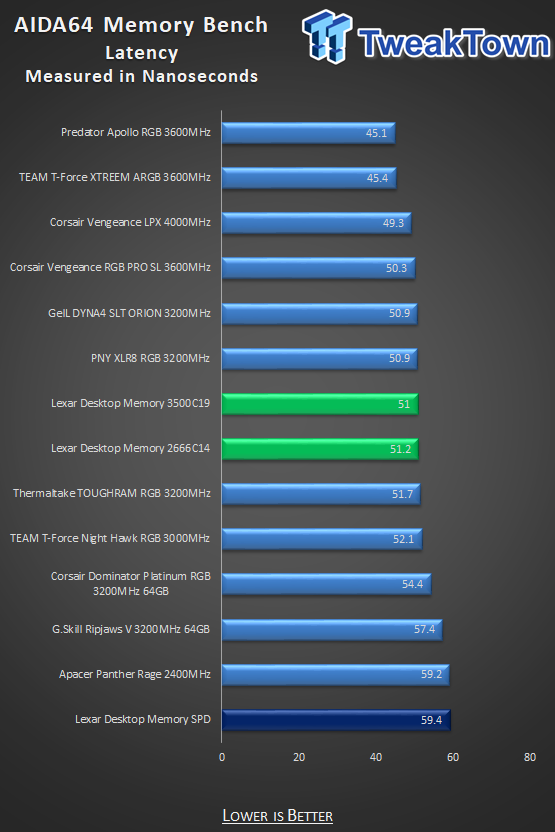
Again, if you base buying RAM on latency, do not look at these results. The Lexar DDR4 takes the last slot on this chart, out of the box, at 59.4ns. When it came to the overclocking results, they do fair better and are nearly tied in their times.
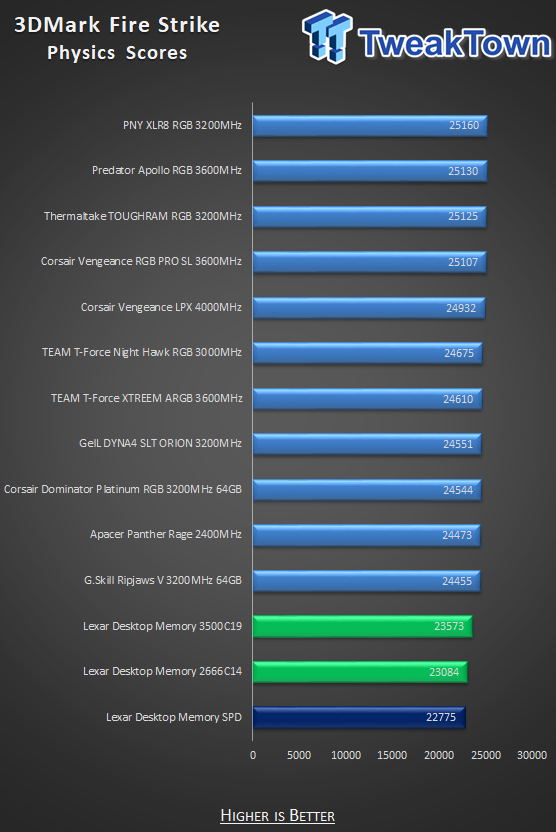
When testing on our AMD platform, we were impressed with the physics scores in 3DMark Fire Strike. However, there is no way to sugarcoat the result on the Intel PC when all three methods of running the Lexar RAM leave them in last place.
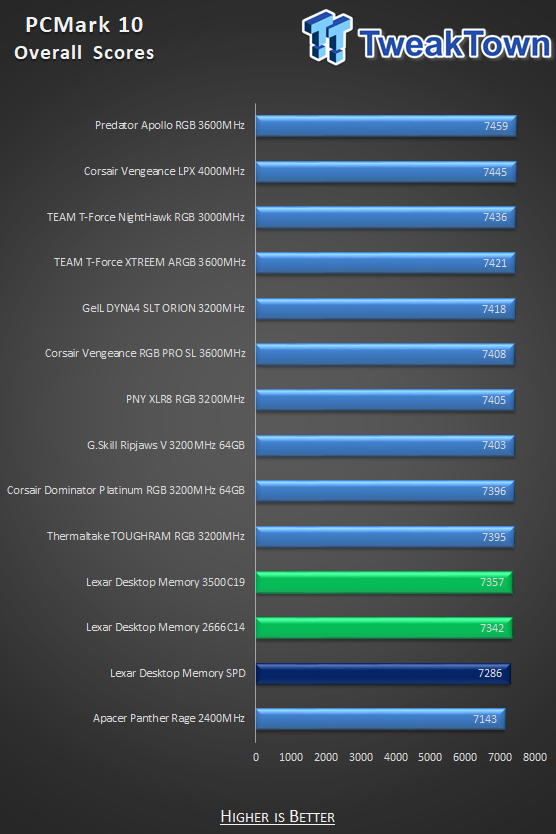
Fresh out of the box, the PCMark 10 results are where they should be, in our opinion. We see a slight boost in performance, opting to lower the timings a bit, but we expected them to place better at 3500 MHz.
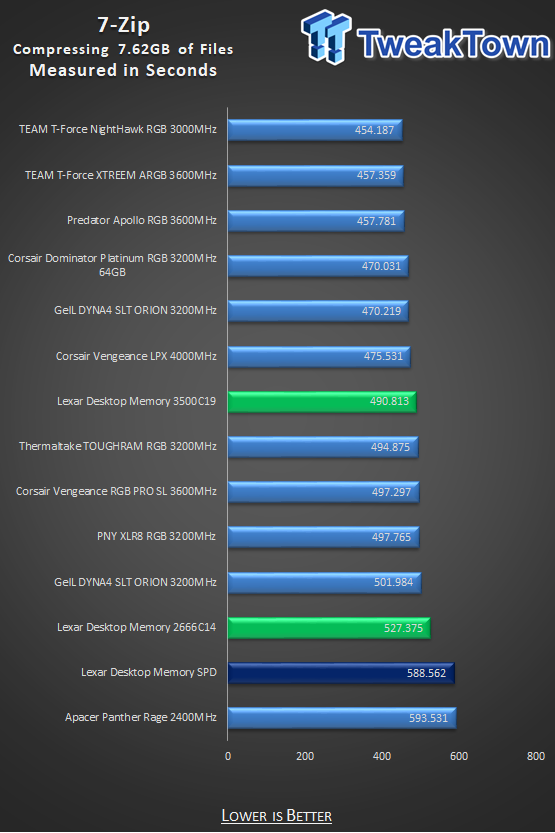
Even with extremely loose timings, the Lexar kit bests the Apacer by roughly 13 seconds. Opting to run them at CAS14 gives us a minute back for every 7.62GB of compressing data, and if you want to run them with more speed, we were able to gain another 37 seconds of our life back.
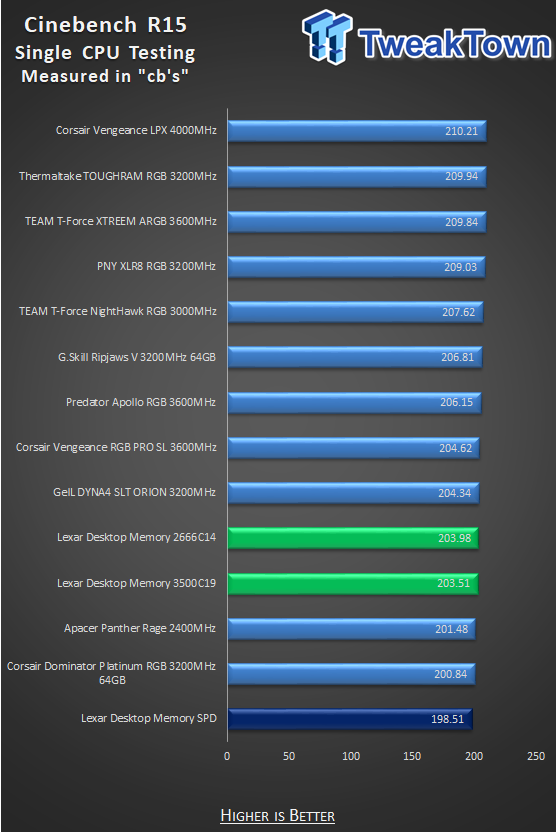
Unlike the results we saw in Cinebench R15 on the AMD rig, with the 10700K in control of the RAM, we know that performance in this metric tanks to last place. Both ways of overclocking beat the Apacer, but timings win over speed in this bench.
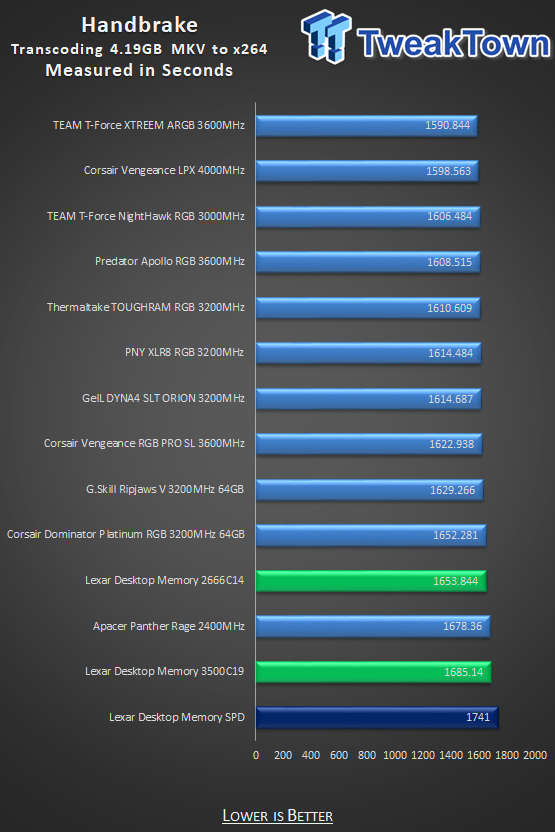
Using these Lexar sticks for Handbrake, as shipped, resulted in a prolonged time to complete. The added speed gained us nearly a minute back in transcoding the same information while running them at 2666 MHz with 14-15-15 timings gained us about ninety seconds over the default setup.
Final Thoughts
Upon first glance, many will see this Lexar DDR4 and think, hmm, naked, generic, slow, and OMG, those timings. However, there is a vast segment of people who do not like RGB lighting, and another smaller subset that knows heat spreaders tend to raise the temperature of RAM, not reduce it. That leaves mostly "value RAM" to look through and see what suits your needs best. We also feel that there are many out there with HEDT systems, where reliability, stability, and plug-and-play installation are desired. Lexar delivers in all of these aspects while sipping power from the motherboard.
Something like these Lexar sticks is also suitable for HTPC use, where nobody will ever see the components, and as to the speed, there are still systems out there that can limit you from 3000/3200/3600 MHz options. For us, it is a departure from the "norm," and this is the type of RAM we started on, which gives us that warm fuzzy nostalgic feeling. Also, unlike many other naked kits out there, we love that Lexar went with the black PCB versus the green we tend to see in the wild.
The performance we gained running this DDR4 as it is intended to be used was mostly expected, although there were a few times where Lexar failed to shine. Many kits deliver these sorts of results, and we cannot recall a single kit that did not wander about in the charts, so we will not hold that against Lexar in our assessment. Opting for lower power means these sticks run cooler than most, and even when we increased voltages, the Lexar kit ran some 5°C cooler than most others we test.
In most instances, when it comes to our DDR4 testing and reviews, we do not go on and on about the overclocking, as it is a bonus, not something guaranteed. However, Lexar has impressed us immensely with the flexibility that it offers. Going from 19-19-19-43 to 14-15-15-43 with mostly a tenth of a volt added to the VDIMM is something that potential customers of Lexar can enjoy and reap the performance benefits. On top of that, going from 2666 MHz to 3400 MHz on the AMD system netted us 734 MHz overclock, which is some of the best results we have seen in all of our DDR4 testing.
Top that with the fact that in the Intel rig, we gained 834 MHz; it blows us away. With minimal effort, you can take what may seem like a mediocre offering and pick whatever level of performance you desire within those spectrums. Except for a very select few kits that have been introduced in the past, it is rare to come by a set of DDR4 such as this.
As much as we glowed about what Lexar is offering, there are two stumbling points. The first is the MSRP. At $64.99 for each 8GB stick, that makes a dual-channel kit in the $130 range, which is top-tier pricing for this segment, based on density, speed, and timings. Anything else in this segment sells for $80 to $100, and for more, you get fancy heat spreaders and RGB. The second issue is availability. As we look around now, we saw a listing at Banggood.com at $55.99, but never using that site; we have nothing to go on for advice as to use them or not.
The usual haunts like Newegg and Amazon will show you SODIMMs but not the sticks we have, which is a bit of a downer. We will end with this thought, though, regardless of price and availability, this is the most fun we have had with any set of RAM in a long time!
Performance |
92% |
Quality |
100% |
Features |
80% |
Value |
85% |
Overall |
89% |
With slower RAM and loose timings, performance out of the box is not amazing. However, in our sample, these Lexar Desktop sticks have a ton of flexibility, and are a ton of fun to overclock!

What's in Chad's PC?
- CPU: Intel Core i7 13700K
- MOTHERBOARD: ASUS ROG Maximus Z690 Hero Eva
- RAM: TEAM DDR5-7200 32GB
- GPU: ASUS GeForce RTX 3090 Eva
- SSD: addlink m.2 2TB
- OS: Windows 11 Pro
- COOLER: Fractal Lumen S36
- PSU: be quiet! Dark Power Pro 1500W
- KEYBOARD: ASUS ROG Strix Scope TKL Electro Punk
- MOUSE: ASUS ROG Strix Impact Electro Punk
- MONITOR: ASUS ROG Swift OLED PG42UQ
Similar Content
Related Tags

